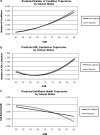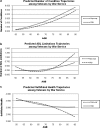Military service and men's health trajectories in later life
- PMID: 20864570
- PMCID: PMC2954333
- DOI: 10.1093/geronb/gbq072
Military service and men's health trajectories in later life
Abstract
Objectives: This study examines differences in the relationship between veteran status and men's trajectories of health conditions, activities of daily living limitations, and self-rated health.
Methods: We use data on 12,631 men drawn from the 1992-2006 waves of the Health and Retirement Study to estimate growth curve models that examine differences in health trajectories between nonveterans and veterans, veterans with and without wartime service, and war service veterans who served during World War II, Korea, Vietnam, and multiple wars.
Results: The results indicate that veterans have better health at the mean age of 66.2 years, but experience greater age-related changes in health than nonveterans. Similarly, men who served during wartime have better health at the mean age, but more age-related changes in health than men who did not serve during wartime. Among war veterans, Vietnam veterans are in poorer health at the mean age, but they experience less substantial age-related health changes than men who served during previous wars.
Discussion: Although veterans experience better health relative to nonveterans around retirement age, they have poorer health than nonveterans among the oldest old. These findings inform our understanding of the veteran-nonveteran health-mortality paradox found in previous research and suggest a health crossover among veterans and nonveterans in later life.
Figures



References
-
- Aldwin CM, Levenson MR, Spiro A., III Vulnerability and resilience to combat exposure: Can stress have lifelong effects? Psychology and Aging. 1994;9:34–44. doi:10.1037/0882-7974.9.1.34. - PubMed
-
- Angrist J. Lifetime earnings and the Vietnam Era draft lottery: Evidence from Social Security administrative records. American Economic Review. 1990;80:313–336.
-
- Angrist JD, Krueger AB. Why do World War II veterans earn more than nonveterans? Journal of Labor Economics. 1994;12:74–97. doi:10.1086/298344.
-
- Bedard K, Deschênes O. The long-term impact of military service on health: Evidence from World War II and Korean War veterans. American Economic Review. 2006;96:176–194. doi:10.1257/000282806776157731. - PubMed
-
- Beebe GW. Follow-up studies of World War II and Korean prisoners. II. Morbidity, disability, and maladjustments. American Journal of Epidemiology. 1975;101:400–422. - PubMed
Publication types
MeSH terms
Grants and funding
LinkOut - more resources
Full Text Sources
Medical

